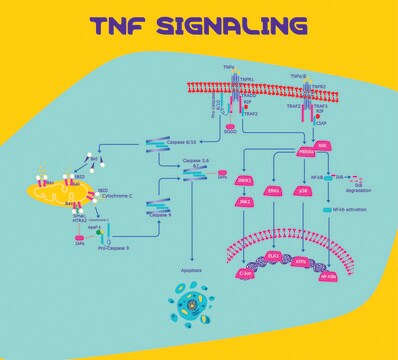推荐产品
生物源
bacterial (Proteus vulgaris)
品質等級
形狀
lyophilized powder
純化經由
phenol extraction
雜質
≤3% Protein (Lowry)
顏色
white to yellow cast
溶解度
water: 4.90-5.10 mg/mL, faintly hazy to hazy, colorless to faintly yellow
運輸包裝
ambient
儲存溫度
2-8°C
一般說明
Lipopolysaccharides (LPSs) are characteristic components of the cell wall of Gram-negative bacteria. They consist of lipid A moiety linked to an antigenic O-polysaccharide.
Proteus vulgaris is a rod-shaped Gram-negative, facultative anaerobe bacterium. It inhabits the intestinal tract of humans and animals and can be found in soil, water and feces. P. vulgaris is a member of the Enterobacteriaceae family which are opportunistic pathogens in humans, responsible for urinary tract and burn infections.
The chemical structures of LPS from Proteus sp. are different from each other.
Proteus vulgaris is a rod-shaped Gram-negative, facultative anaerobe bacterium. It inhabits the intestinal tract of humans and animals and can be found in soil, water and feces. P. vulgaris is a member of the Enterobacteriaceae family which are opportunistic pathogens in humans, responsible for urinary tract and burn infections.
The chemical structures of LPS from Proteus sp. are different from each other.
生化/生理作用
LPS and its lipid A moiety stimulate cells of the innate immune system by the Toll-like receptor 4 (TLR4), a member of the Toll-like receptor protein family, which recognizes common pathogen-associated molecular patterns (PAMPs). Different chemical structures of LPS can be associated with the virulence and pathogenesis of the bacteria. It has been reported that the LPS chemical structure from P. vulgaris can influence the crystallization of mineral urine components (such as calcium and magnesium), resulting in stone formation in the kidney. Antibodies produced in rickettsial infections were found to react with LPS from Proteus vulgaris and Proteus mirabilis. This phenomenon allows the purified LPS from these two species to serve as a tool for the diagnosis of rickettsiosis (scrub typhus, caused by the bacterium Orientia sp.) in the Weil-Felix test.
其他說明
To gain a comprehensive understanding of our extensive range of Lipopolysaccharides for your research, we encourage you to visit our Carbohydrates Category page.
相關產品
儲存類別代碼
11 - Combustible Solids
水污染物質分類(WGK)
WGK 3
閃點(°F)
Not applicable
閃點(°C)
Not applicable
LPS/TLR4 signal transduction pathway
Lu, Y.C., Yeh, W.C., Ohashi, P.S.
Cytokine, 42, 145-151 (2008)
S Mizushiri et al.
Microbiology and immunology, 34(2), 121-133 (1990-01-01)
The lipopolysaccharides (LPS) extracted from Proteus strains OX2, OX19, and OXK used as antigens in the Weil-Felix test, were characterized by chemical analysis and SDS-polyacrylamide gel electrophoresis (SDS-PAGE). To separate the O-polysaccharide, core-oligosaccharide, and lipid A moieties, each LPS was
B Bartodziejska et al.
European journal of biochemistry, 256(2), 488-493 (1998-10-06)
The following structure of the O-specific polysaccharide chain (O-antigen) of the Proteus vulgaris 032 lipopolysaccharide (LPS) was established by 1H-NMR and 13C-NMR spectroscopy, including two-dimensional NOESY and H-detected 1H,13C heteronuclear multiple-quantum coherence (HMQC) experiments: -->2)-alpha-L-RhapI-(1-->2)-alpha-L-RhapII-(1-->4)-beta-D-++ +GalpA(I)-(1-->3)-beta-D-GlcpNAc-(1-->4)-alpha-D-GalpA(II)-(1-- >. In addition, an
Agnieszka Torzewska et al.
Journal of medical microbiology, 52(Pt 6), 471-477 (2003-05-16)
Formation of infectious urinary calculi is the most common complication accompanying urinary tract infections by members of the genus Proteus. The major factor involved in stone formation is the urease produced by these bacteria, which causes local supersaturation and crystallization
A Torzewska et al.
FEMS immunology and medical microbiology, 31(3), 227-234 (2001-11-27)
The O-specific polysaccharide (O-antigen) of the lipopolysaccharide (LPS) of Proteus vulgaris O37 was studied by (1)H and (13)C nuclear magnetic resonance spectroscopy before and after O-deacetylation and found to be structurally similar to that of P. vulgaris O46 studied earlier.
我们的科学家团队拥有各种研究领域经验,包括生命科学、材料科学、化学合成、色谱、分析及许多其他领域.
联系客户支持


